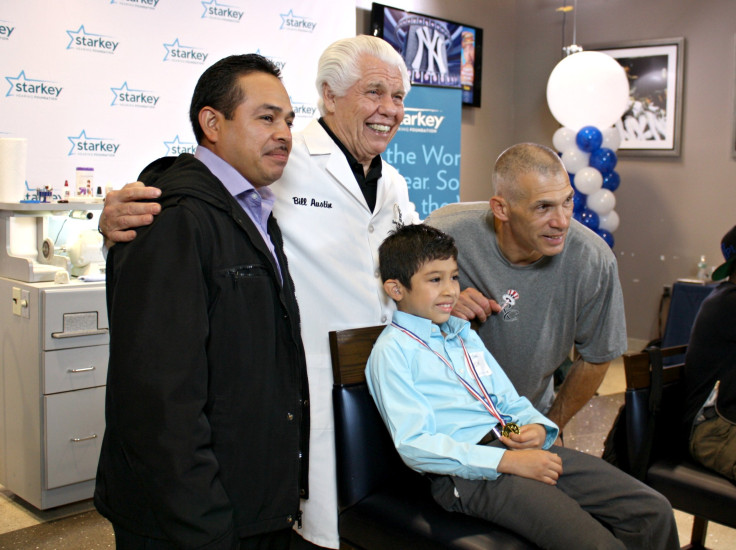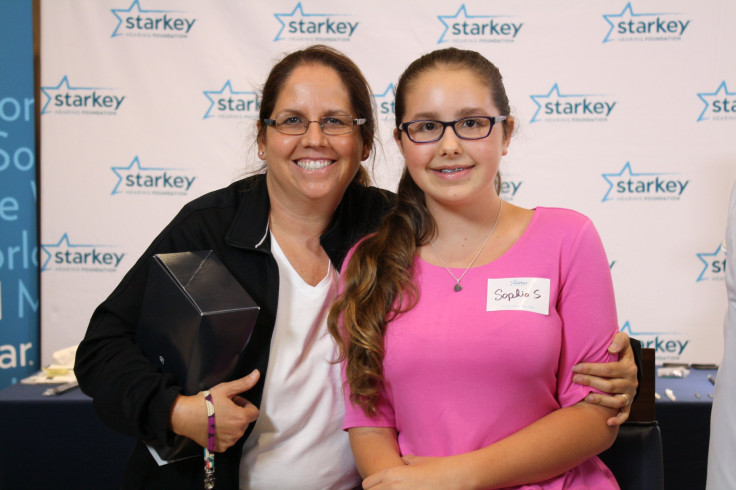Giving The Gift Of Hearing Aids: Starkey Hearing Foundation Helps People With Hearing Loss By Facilitating Connections

Sophia Stamos was 7 years old when she got her first hearing aids. Now 12, Sophia will be receiving another state-of-the-art pair, created, customized, and paid for by the Starkey Hearing Foundation. But despite growing up with hearing loss and learning a modest amount of sign language to compensate, her family still has no idea when it began.
“Sophia was extremely intuitive and curious when she was little, but nobody could understand her,” her mother told Medical Daily, adding that she underwent therapy with many different speech pathologists, “but not one speech therapist said to her, ‘Why don’t you get her hearing checked. As a parent, I’m like, ‘That’s your profession, how did you not know?’ And to me, had we known, we would have been able to treat her earlier. It would have been more beneficial for Sophia.”

Sophia’s story seems to mirror so many other cases of children with hearing loss. Affecting 20 percent of Americans, including every 30 out of 1,000 school children, hearing loss is a lot more common than it’s perceived to be. But because we often associate hearing loss with the elderly, the condition is frequently misdiagnosed within children as a learning disability. As a result, hearing loss may not be identified until later, when other options like speech therapy don’t seem to be working.
Diagnosing hearing loss, however, is only the beginning. Next comes providing treatment, which is very difficult for most families to afford.
“It’s not covered by insurance because they say it’s ‘medically unnecessary.’ But when you get glasses, you pay half if you have good insurance. How can you not pay at least half for the hearing aids,” her mother said. “I think hers were at an estimate of $8,000 the first time around, and my husband and I were like, ‘How are we going to pay for that?’”
But if hearing and vision are both essential senses that allow a child to learn and experience the world, why is fixing the impairment of one deemed more ‘medically necessary’ than the other?
Glasses Are Cool, Hearing Aids Aren't
Talking with Jennie Noska, a fourth-year audiology student from CUNY graduate school, who fitted Sophia for her new devices, it became even more apparent how we need to rethink the way we treat hearing aids.
“If [kids] don’t get hearing aids at a young age when they need them, then they won’t produce the proper sounds because they can’t hear to reproduce those sounds,” she said. “Maybe if they just had hearing aids when they were little, they wouldn’t have had to attend a special class and maybe their reading scores would be better. People don’t often realize that it could be hearing loss that’s contributing to their struggles when it didn’t need to.”
Children with hearing loss also face social isolation because they can’t fully participate in conversations. And when they finally do get hearing aids, it becomes another sign they are different, especially since they’re wearing the same device their grandmother may have. “You associate hearing loss with old age, but glasses are now becoming a fashion statement,” Noska said.

'So the World May Hear'
Every year, the Starkey Hearing Foundation helps thousands of children like Sophia overcome the financial hurdles and stigmatization of hearing aids. This week, the Foundation teamed up with the New York Yankees and various organizations to provide the gift of hearing to nearly 100 children and adults with hearing loss, including 20 Holocaust survivors living in the New York City area. The event came just in time for National Audiology Awareness Month, a time of the year dedicated to educating the public about hearing loss and interventions, and getting people the treatment they need.
If you were to ask Bill Austin, the co-founder of the Starkey Hearing Foundation, what it is like to help someone hear the world around them, he would tell you, “It’s like turning on a light switch. It’s taking them from full darkness into color. When something is silent it’s dead. Sound is life, it’s vibration, it’s moving. To listen to other people, to be able to hear the inflection in their voice, to feel the person, you hear the road to the heart. We’re lucky to do this special work.”
Disabled hearing loss affects more than 360 million people, including 32 million children worldwide. In India alone there are 183,000 children who don’t attend school because of a hearing disability. Austin said every single one of those children will be fitted with hearing aids by the end of 2016.

As a young man, Austin wanted to be a doctor to save lives and impact the world. He paid his way through college with the money he earned from an invention made to improve hearing aids. The turning point in his life came one day as he was fitting a hearing aid into an older man’s ear. The moment the man could hear again, his eyes lit up, and the gravity of Austin’s work was realized. That night, while riding the bus home, Austin knew this was the way he would reach the world.
“I looked at my two hands, and I said, ‘Bill, you’re a clinical guy,’” he told Medical Daily. “‘You’re not going to do a vaccine, you don’t like being in a lab, you like people. How many can you help a day, 50? Twenty-five patients maybe, depending on what’s wrong with them? And you’ll spend your life impacting one village, but you feel like you belong to the world.’ I saw the answer to that with business.”
He realized his own limitations and inability to reach the thousands, even millions, that he had dreamed of reaching if he did it alone. Instead, he said he needed to form teams and realized that if the business’s bottom line was people and not money, then he’d be able to create a service flow. He took money from people who could afford to pay and helped the ones who couldn’t, so that everyone, not just the wealthy, could have the gift of hearing.
Starkey Hearing Technologies was founded from this, and in 1978 Austin created the Starkey Fund to raise money for people in need of hearing assistance. Once a financial backbone was put into place, Austin and his wife Tani were able to start the Starkey Hearing Foundation. They began traveling around the world to help those who can’t afford hearing aids, sometimes spending only a month out of the year at home.
The foundation currently fits more than 200,000 children and adults from around the world with free hearing aids each year — a dramatic increase from the 50,000 fitted just five years ago. A beaming Sophia, who proudly showed off her new, almost-undetectable hearing aids, got to be one of these lucky children.
“Our job is to start a wave of good,” Austin said. “We’re hoping that we can reach a critical mass that creates enough to reflect a light that will start to drive back the darkness in the world, so people will feel hope. Hearing connects us as one human family.”



























